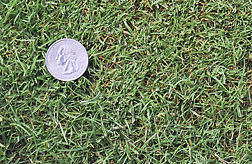This page has been archived and is being provided for reference purposes only. The page is no longer being updated, and therefore, links on the page may be invalid.
| Read the magazine story to find out more. |
|
|
|
|
First Linkage Map of Creeping Bentgrass Completed
By Sharon Durham
October 31, 2014
The first ever linkage map for creeping bentgrass, a commonly used turfgrass, was completed by U.S. Department of Agriculture (USDA) scientists in collaboration with researchers at Rutgers University and at the University of Massachusetts. This turfgrass has a tolerance for low mowing that allows it to thrive where other grasses would die.
Plant geneticist Scott Warnke and his colleagues at USDA's Agricultural Research Service (ARS) are using molecular genetics to determine the genetic workings of turfgrasses like creeping bentgrass. Warnke is with the U.S. National Arboretum's (USNA) Floral and Nursery Plants Research Unit in Beltsville, Maryland.
According to Warnke, the linkage map will help eventually in marker-assisted breeding of economically important traits, such as disease resistance to dollar spot and brown patch, which are common diseases of bentgrass. This type of research will help develop improved turfgrass germplasm that requires less pesticide, fertilizer and water.
Improved germplasm will be released to plant breeders at public and private institutions for further development and eventual release of new cultivars. This research, as well as other work similar to it, has led to the "Grass Roots" initiative, a collaborative effort between USNA and the National Turfgrass Federation.
The program consists of an outdoor interactive exhibit; extensive information on the Web that complements the outdoor exhibit; workshops, product demonstrations and symposia; and the development of the National Greenscape Corridor—a cooperative effort linking the National Mall, Arlington National Cemetery and USNA.
The outdoor interactive exhibit is in a 1-acre space adjacent to USNA's Administration Building and Visitor Center located in Washington, D.C. The exhibit features 12 stations including irrigation, fertilization, sports fields, turf diseases and pests and grass types. The outdoor exhibit design was developed by a team led by head horticulturist Scott Aker.
One part of the exhibit, the irrigation station, conveys a message any visitor can use: "Save water." To help consumers learn about smart water usage, different water-efficient sprinkler heads are displayed.
ARS is the USDA's chief intramural scientific research agency, and this research supports the USDA priority of responding to climate change.
Read more about this research in the October 2014 issue of Agricultural Research magazine.

